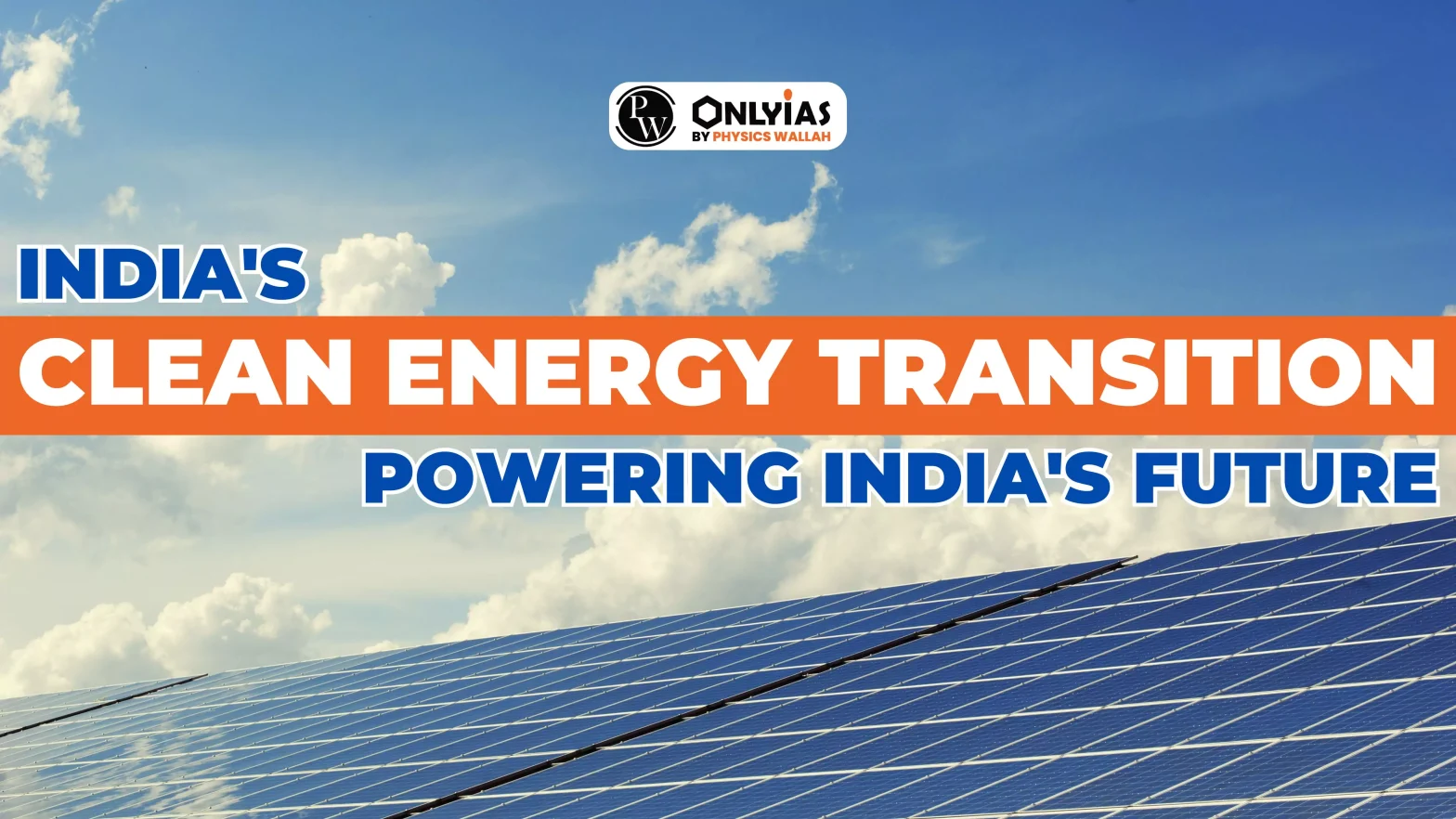In her seventh consecutive Budget speech, the Finance Minister announced measures indicating India’s commitment to its clean energy transition.
| Relevancy for Prelims: Renewable energy, Council on Energy, Environment, and Water (CEEW), India’s power generation mix, Saubhagya scheme, etc.
Relevancy for Mains: Challenges and opportunities in India’s transition to clean energy. Measures to ensure a sustainable power sector, etc. |
India’s Clean Energy Transition, Powering India’s Future Powering India’s Future
- These measures include developing policies on pumped hydro storage, and energy transition pathways to support nuclear energy and energy efficiency.
- Yet, the memories of this summer’s record- breaking heatwaves, which drove up power demand, are still fresh.
- They reflect both a growing economy and a warming climate. What will it take to keep India’s economy powered?
- For the NDA government, energy security and the clean energy transition have been the priorities.
- This is evident from three key milestones India has achieved in the last decade.
- First, near-universal electrification through the Saubhagya scheme, with independent surveys by the Council on Energy, Environment, and Water (CEEW) suggesting that approximately 97% of households were electrified in 2020.
- Second, the country saw a five-fold increase in installed renewable energy (RE) capacity, making India the fourth-largest country globally by RE capacity.
- Third, there was a 40% drop in aggregate losses of power distribution companies (discoms), to an all-time low of about 15% in 2022-23.
- These indicate that the base of the Indian power sector is strengthening.
- However, India confronts challenges in decarbonising its power system at speed and scale while supplying quality and affordable power to consumers.
- Moreover, India’s power sector must prepare for stronger headwinds.
- Our annual electricity demand has been growing by 7-9% every year since the COVID-19 pandemic, But our peak demand is rising even faster.
- Climate change-induced weather extremes further exacerbate these challenges.
- For discoms, meeting unplanned surges through affordable options and existing network capacity is challenging, resulting in power outages.
Enroll now for UPSC Online Course
To Address the Concerns
- First, the government must raise targets for renewable energy and storage systems to go beyond 500 GW in 2030.
- Despite past efforts to add renewable capacity, its share in India’s power generation mix is just 13%.
- Previous power supply shortages and expectations of rising energy demand have driven policymakers to bet on new coal capacity.
- Instead, we must strive to raise the share of renewables in India’s power generation mix and scale up storage solutions.
- Renewables and storage can support peak demand, are cost-competitive, and are faster to build.
- Second, steer faster deployment of diverse clean energy resources.
- In 2023 alone, China added 300 GW of solar and wind capacity, while the European Union added 73 GW.
- As of March, India’s cumulative renewable capacity stood at 144 GW, with another 128 GW in the pipeline.
- This comparison indicates the urgency of deploying clean resources at speed and scale.
- This requires tapping the RE potential in more States as well as faster grid connectivity and access to suitable, conflict-free land for the timely commissioning of projects.
- Diversifying from solar energy to other clean technologies would also help India meet its evolving demand.
- Third, implement measures to improve the availability of energy.
- During FY23, only 6.3% of India’s power generation was procured through power exchanges, with the rest coming through bilateral agreements.
- The low liquidity (volume being traded) in the power exchange presents price volatility risks.
- This restricts both buyers and sellers from relying on the exchange for power procurement and value recovery, and in turn, constrains our ability to integrate renewables at scale.
- India needs innovation in bid designs to attract RE developers to sell power in the exchange, besides setting up capacities for long-term contracts.
- For instance, under the RE Implementation Agency-led bidding process, RE developers may be required to build part of the project capacities for merchant sale, beyond the bid quantum for long-term contracts.
- Fourth, ensure effective maintenance and utilisation of the coal fleet.
- Even as we add more renewables, coal plays an important role.
- CEEW’s analysis of MERIT data shows that, in FY24, more than 210 GW of coal capacity generated about 80% of the power during non- solar hours.
- However, more than 40 GW of coal capacity was unavailable for nearly 60% of the time that year, due to planned maintenance or technical faults.
- State regulators must revise the norms to enable timely upkeep of the coal fleet and compensate for investments to make select coal plants flexible.
- Finally, fast-track digitalisation to empower discoms and consumers to play an active role in India’s energy transition.
- Smart meters would enable discoms to forecast power demand accurately, plan networks better, and integrate renewables cost-effectively.
- More than 11 million smart meters have already been installed in India, with half of
- these in Bihar and Assam.
- However, India’s smart metering drive is far from the 250 million target.
- Discoms must overcome their hesitation and take inspiration from Bihar and Assam, which are already reaping benefits like reduced losses and timely bill delivery to consumers through smart metering.
- But keeping consumer privacy and system preparedness against cyberattacks at the heart of regulations and digitalisation efforts would be crucial.
- All eyes are on the Indian government to deliver in this critical decade.
- Investing in a cleaner, flexible, and resilient power grid will help our economy grow sustainably and create jobs in the clean energy sectors.
Check Out UPSC CSE Books From PW Store
Conclusion
India’s future energy security hinges on accelerating renewable adoption, enhancing grid resilience, and digitalizing systems. Effective policies and investments will drive sustainable growth and job creation.
![]() 7 Aug 2024
7 Aug 2024

